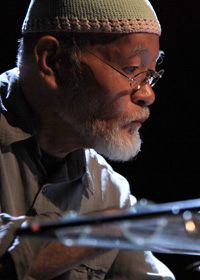|
Akio Suzuki
(b. 1941 in Pyongyang, North Korea)
Akio Suzuki is a Japanese artist born in North Korea. At the age of four he moved to Japan, to a town called Aichi. He became well known as a pioneer of sound art, but the breadth of his activities and the form of his works far exceeds the normal boundaries of sound art. It is perhaps more as a “quester after sound and space” that he has received the most attention from artists in many fields. Suzuki’s journey as an artist began in 1963 with a performance at Nagoya station, in which he threw a bucket full of junk down a staircase. The inspiration behind this performance - the idea that if one were to hurl an object down a well-balanced stairway, a pleasant rhythm might be the result - took the desire to “listen” as its subject. That desire to hear, to listen has remained the one constant in Suzuki’s stance as an artist.
During the sixties, Suzuki’s sense of playfulness led him to undertake a series of Self-Study Events, where he explored the processes of “throwing” and “following”, taking the natural world as his collaborator. The experiences he gained in these events led him in the seventies to invent an echo instrument he named Analapos. The instrument’s structure resembles that of two mirrors facing each other, reflecting into infinity. As an extension of the principles underlying Analapos, Suzuki constructed the Space in the Sun in 1988. This space consists of two huge parallel walls, in between which the artist can sit all day and purify his hearing by listening to the reflected sounds of nature. This space leads the artist to discover a new method of listening. Suzuki himself comments, “Sound, which had been conceptually imprisoned in various spaces, is freed to circle the world.”
From the late seventies and through the eighties, Suzuki also developed a form of performance he refers to as Conceptual Soundwork. Applying a number of self-imposed, simple and austere rules, he uses objects close at hand in a mode of “intellectual play”. While these events do on the one hand express a critique of meaningless improvised performance, at the same time Suzuki is constantly aware of the audience’s process of listening and he attempts to create contemporaneous connections with the site of performance. It was around this time that Suzuki began to travel frequently to Europe, and his performances at leading music festivals, Festival d’Automne (Paris, 1978) and Documenta 8 (Kassel, 1987) were rapturously received.
As sound art enjoyed a period of prosperity in the nineties, Suzuki was given the chance to create many installations, particularly in Europe. Worthy of special note were his soundless installations, such as Otodate (since 1996) in Berlin, Paris, Strasbourg and Wakayama, Hana (since1997) in Saarbrucken and Trino. These soundless pieces were not designed to critique the old perceptual theories of music, rather they questioned the very location of music.
To run simultaneously with these experiments, Suzuki has started the Mogari series since 2002. This series centres around unbelievably powerful performances on iwabue - ancient and naturally-sculpted stone flutes which have been handed down in Suzuki’s family. Using these ancient instruments Suzuki sculpts time and place, and through their music he searches for his own end.
Suzuki’s performances and installations have been presented by numerous top class festivals and museums in several continents since the seventies such as The National Museum of Modern Art (Kyoto, 2007), Resonant Space (various locations in Scotland, 2006), Musee Zadkin (Paris, 2004), British Museum (London, 2002), Donaueschingen Festival (Donaueschingen, 1998), Japan House (New York, 1983), and many others. He has awarded many grants and residencies including DAAD (Berlin, 1994) and Rockefeller (Asian Cultural Council) Grant (New York, 1981).
Full CV in PDF
|

Full CV in PDF
|